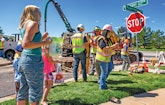
A Colorado Springs Utilities crew uses a RAMVAC HX12 hydroexcavator and a CAT 328D excavator to carefully uncover a leaking 36-inch transmission line serving customers in the Northgate and Briargate areas of the city. (Photography by Carl Scofield)
Like every municipal provider of water services, Colorado Springs (Colorado) Utilities walks a tightrope. Not falling off that slender platform is all about balancing the needs and wants of utility consumers.
Demand too much regulatory compliance in exchange for a fat fee and...









